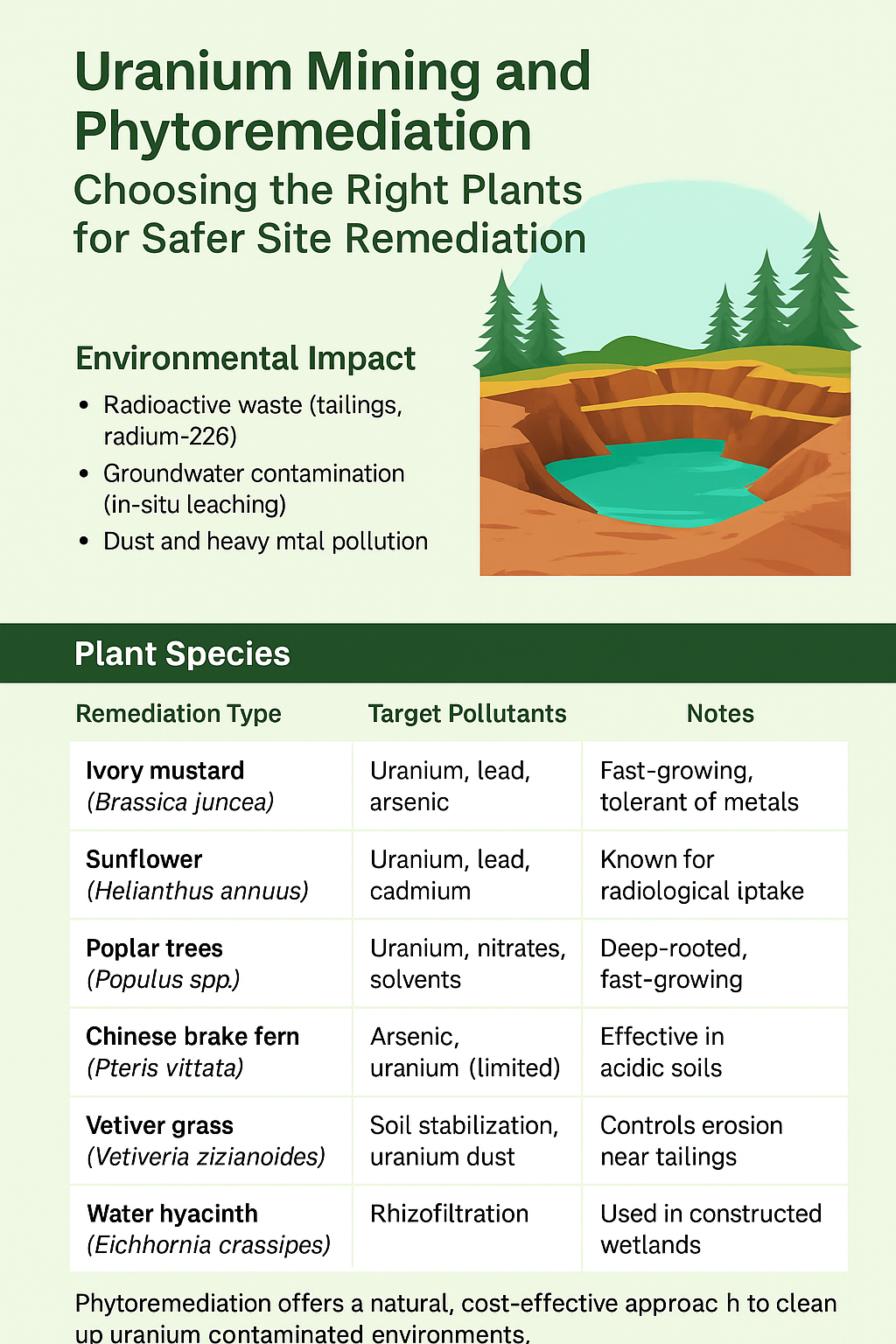Uranium mining has fueled nuclear energy development and defense systems for decades—but it has also left behind a legacy of environmental contamination. From radioactive tailings to heavy metal pollution and toxic dust, abandoned uranium mines pose significant risks to soil, water, and human health. As the world shifts toward more sustainable remediation strategies, phytoremediation—using plants to clean up contaminated environments—has emerged as a promising natural solution.
This article explores the dangers of uranium mining, the science of phytoremediation, and how to select the right plant species to clean up radioactive and heavy metal-contaminated sites.
⚠️ The Environmental Impact of Uranium Mining
Uranium mining operations produce large volumes of radioactive waste, including:
-
Tailings: Residual ore left after uranium extraction, often laced with radium-226, thorium, and arsenic.
-
Dust and particulates: Can spread radioactive materials through air and water.
-
Groundwater contamination: Especially in in-situ leaching operations, where chemical solutions can leach uranium and other heavy metals into aquifers.
Many of these abandoned or poorly managed sites are found in indigenous lands or rural regions, where long-term exposure has caused serious health and ecological consequences.
🌿 How Phytoremediation Can Help
Phytoremediation offers a non-invasive, cost-effective, and environmentally friendly alternative to mechanical or chemical remediation. In uranium mining sites, specific plants can be used to:
-
Absorb uranium and other metals from soil and water (phytoextraction)
-
Stabilize radioactive materials in place (phytostabilization)
-
Filter contaminated runoff using root systems (rhizofiltration)
-
Rebuild topsoil and reduce erosion, improving the long-term viability of reclamation
🌱 Choosing the Right Plants for Uranium Remediation
Not all plants can survive in or remediate uranium-rich environments. Selecting the right species depends on factors like climate, contamination type, depth of pollutants, and whether you're dealing with surface soil, deep leaching, or tailings ponds.

1. COGEMA Mine (France)
Field studies found that Brassica juncea and sunflowers grown on uranium-contaminated tailings were able to reduce bioavailable uranium by over 60% in 90 days, without external fertilizers.
2. Church Rock, New Mexico (USA)
Following a uranium mill spill on Navajo land, native willows and buffalo grass were planted as part of a phytostabilization pilot. The plants successfully prevented wind erosion, reduced surface contamination spread, and showed potential for deeper-rooted species.
3. Jaduguda Uranium Site (India)
Indian mustard was trialed on residual uranium-contaminated farmland. After two growth cycles, uranium uptake in plant shoots was confirmed, with soil samples indicating a 30% reduction in soluble uranium levels.
⚙️ Practical Considerations
To succeed with phytoremediation in uranium mine cleanups:
-
Soil testing and mapping are essential before planting.
-
Amendments like biochar or chelating agents may be needed to improve uptake.
-
Multiple growth cycles may be required depending on contamination severity.
-
Biomass disposal must be handled with care—contaminated plant material may require secure storage or incineration under radiation safety protocols.
🧩 Combining Phytoremediation With Other Techniques
A blended approach often yields the best results:
-
Phytoremediation + Passive Wetlands: For treating runoff and tailings pond discharge.
-
Phytostabilization + Surface Capping: To prevent wind dispersion of radioactive dust.
-
Revegetation with Native Species: Ensures ecological restoration and long-term sustainability.
🌎 Conclusion: Greening the Gray Legacy of Uranium Mining
Phytoremediation is not a silver bullet, but it is a powerful tool for remediating uranium-contaminated landscapes in a way that is natural, cost-effective, and culturally appropriate, especially for indigenous and rural communities near abandoned mines.
As nuclear energy sees renewed interest worldwide, environmental restoration of legacy sites must go hand in hand with progress. Through smart plant selection and science-backed implementation, we can help turn radioactive scars into regenerative green spaces.
✅ Next Steps:
-
Conduct phytoremediation trials on decommissioned uranium sites.
-
Engage local communities in planting and monitoring programs.
-
Expand research on genetic modification for metal uptake efficiency.
-
Push for government policy support and remediation funding.
